|
James Powell Jones was an energetic and enthusiastic
antiquarian known for his archaeological and historical
research. Born in Tettenhall on the 25th of
February 1857, he spent his early years in Newbridge
Cottages. His grandfather, Richard Jones, a gardener from
Worfield in Shropshire, married Elizabeth Powell from
Shifnal. His mother, Pamela Jones, was christened on the 9th
of December 1835 in St. Peter’s Church, Wolverhampton, but
died when James was a young boy.
|
|

James P. Jones |
James P. Jones was rumoured to be the illegitimate son of
one of the Wrottesley heirs and bore a remarkable likeness
to Lord Arthur Wrottesley. His christening, marriage and
funeral took place in Tettenhall’s Church of St. Michael and
All Angels.
On his baptism and marriage records his father’s
name is noticeable by its absence but the Wrottesleys kept
in close contact with him throughout his life and it is said
that they paid for his education.
George Wrottesley, the second son of Baron John Wrottesley,
was a veteran of the Crimean War. He had no children from
his marriage to Sir John Burgoyne's daughter, Margaret.
James became his protégé and was given unprecedented access
to the Wrottesley archives.
George and James were both
interested in the military and both
set up archaeological societies of their own. While
George was instrumental in founding the William Salt
Archaeological Society and was a military historian, James,
a local historian, founded Wolverhampton Archaeological
Society. In 1923 James published a History of The South
Staffordshire Regiment. He had been a member of Tettenhall’s
Volunteer Regiment (M Company, Third Battalion).
|
|
James’ first school may have been in Tettenhall village. The
school rooms were built to replace classes held in the
church vestry. As he grew older, he continued with his
studies and became an accomplished scholar. Old exercise
books in which he pasted news cuttings of local interest
show that he wrote Latin. In an article on Tettenhall Church
he described how he produced his own translation from the
old contracted Latin of the Rolls. The 1881 census for
Tettenhall shows James Jones aged about 24, living in
Waterworks Lane with a cousin, Richard Simkins, thirty years
his senior. |
|
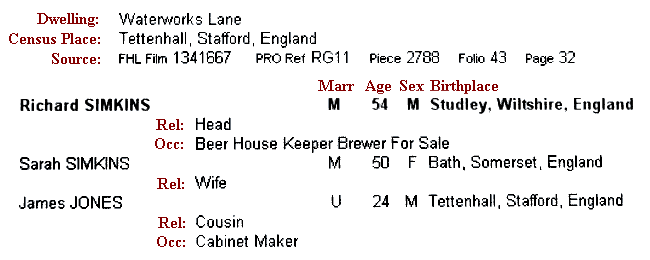
From the 1881 Census. |
|
By 1883 James was putting on performances for Tettenhall’s
Amateur Dramatic Society. Not only was he stage manager but
he took a leading role in the productions. Amongst the cast
was a certain Miss Farnall. On October 5th 1886
James married this budding actress whose name was Rose-Anna.
Her grandfather, William Farnall, came from a race of sturdy
local Yeomen. William could remember Tettenhall Wood as a
great open common ‘luxuriant with gorse, hazel and
blackberry bushes’. Rose-Anna’s grandmother, Ann Farnall
(nee Rodes) was the last representative of an old Shropshire
family from Condover near Shrewsbury, and had been a
landowner in Tettenhall Wood in 1793.
After their marriage James and Rose-Anna lived in Walsall
for a short while. In 1888, their only daughter, Rose, was
born and James proudly recorded details of her christening
in St. George’s Church. By 1891 James and his family had
returned to live in Tettenhall where he and his wife were
still actively involved in the local dramatic society. James
was also a keen churchman and became a member of the vestry
committee. In addition to history and archaeology, James was
interested in photography. He sold his photographs
commercially and also produced postcards of local scenes.
In 1887 he recorded Tettenhall’s celebrations for Queen
Victoria’s Jubilee. In 1890 James gave his first lecture on
the history of the village to a very receptive audience in
the Drill Hall situated in Old Hill.
James worked full time but much of his leisure involved
his passion which was writing. He frequently contributed
articles to local newspapers. In June 1894, he published A
History of the Parish of Tettenhall, in the County of
Stafford. The following advert was published in the
Birmingham Daily Post 26th October 1893: |
|
We have received a prospectus of a
forthcoming history of this parish by Mr. James P.
Jones of Lime Road, Tettenhall, to be published by
subscription in the course of a few weeks. The work
will contain copies of many historic and ancient
deeds, a complete record of the various manors, an
exhaustive account of the church, and many details
of family history. There will be many illustrations
and the frontispiece will be a charming etching of
Barnhurst by that brilliant etcher, John Fullwood,
R.B.A. We have seen a proof of this etching, the
execution of which is masterly. These parish
histories often contain valuable matter not easily
accessible elsewhere, and , as the cost of producing
them is generally out of proportion to the demand
for them, their authors have something like a claim
on those interested in local antiquities, genealogy
etc. |
|
| James P. Jones and the Wolverhampton artist, John
Fullwood, were contemporaries whose mutual goal was to
record the area before it changed irrevocably. Their
friendship went beyond their commercial transactions. Three
years previously, John had given James a personal invitation
to his December exhibition in Burlington Chambers, New
Street, Birmingham.
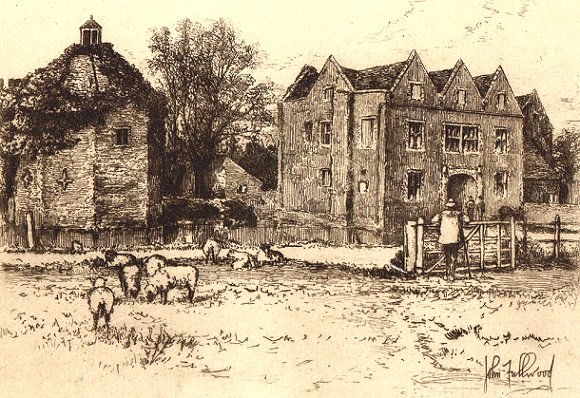
Barnhurst by John Fullwood.
One of James’ greatest achievements was to establish
Wolverhampton Archaeological Society with his friend, Alfred
Webb, the Wolverhampton publisher and printer. Alfred was
born in Tettenhall Wood in 1847 and lived there for many
years with his wife, Harriet and his son, Archie. He was
noted for A Webb’s Parish Almanac for Tettenhall and
Tettenhall Wood and for A. Webb’s Annual. As the
product of an ‘upstairs/ downstairs relationship’, James P.
Jones firmly believed that knowledge was not just for the
rich. The vast majority of members were from the educated
middle classes but were not necessarily wealthy. However, a
certain amount of money was needed and in 1895 James and
Alfred managed to attract some distinguished backers, such
as the colourful Colonel Thorneycroft of Tettenhall Towers
who agreed to be President in its first year- “to give it a
start.” |
|

From the 1913 Wolverhampton Red Book.
|
|
Meanwhile James’ daughter, Rose, was growing up and showed
every sign of inheriting her father’s love of history.
Photographs show her accompanying her parents on
Wolverhampton Archaeological Society's famous excursions from
a very early age. Rose-Anna and Rose not only compiled the
indexes for James P. Jones’ books but also wrote articles on
local history for Alfred Webb’s Annual. James and
Alfred encouraged women to have a voice. Rose, a teenager
when she wrote the articles, became very involved in the
Society. She and her mother helped to preserve its
memorabilia in three huge and detailed scrapbooks of
lectures, events, membership fees, accounts, obituaries,
musical evenings, and excursions. These outings included
taking a charabanc from Cleveland Street, visiting places of
interest and talks from various members and guest speakers.
These events always included lunch or tea. The excursions
for 1895 were to Weston Park, where a paper was read by
Revd. C. Callow, of Whipton, on “A Visit to Wharfedale”, and
to Tettenhall Towers, where the paper was given by Mr. G.T.
Lawley on ‘Dialects of the District. His lively humour was
much appreciated. |
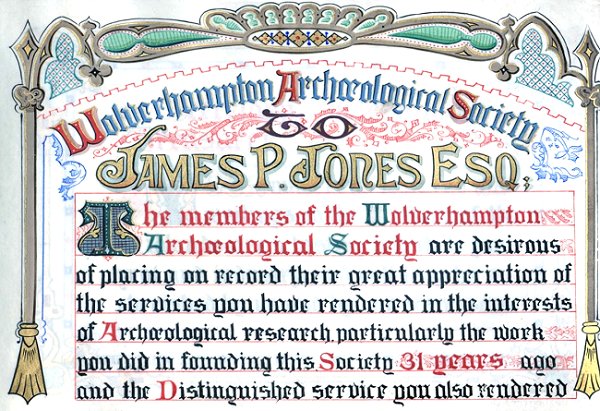
A page from the manuscript that
was presented to James P. Jones in 1926 by the
Wolverhampton Archaeological Society. |
|
Wolverhampton Archaeological Society may have been founded
in 1890s but the story did not begin there. John Elliot,
born in 1832, started his career as a compositor in the
office of The Wolverhampton Chronicle.
He was on the committee of the Wolverhampton
Temperance Society and was one of the oldest members of the
Chillington Lodge of Oddfellows. Wolverhampton already had
an exclusive, privately funded subscription library and
there was huge opposition to the idea of a Free Library as
it meant an increase in taxes. However, people had not
reckoned on John Elliot’s remarkable drive and energy. A
Free Library Pioneer, he represented Wolverhampton at
National level as one of the earliest members of the Library
Association of the United Kingdom.
John devoted much of his spare time to improving educational
facilities for Wolverhampton’s population. This drive for a
more inclusive society lay at the heart of many of
Wolverhampton’s Educational ventures. The Free Library
became so popular and grew so rapidly that a new building
was built at the corner of Garrick Street and Cleveland
Road. John, a Fellow of the Royal Historical Society,
also helped to establish the Working Men’s College in
the Old Grammar School Building in John Street. However, it
closed through lack of support. Evening classes began in
1874 connected to the thriving Technical School which John
Elliot also supported. The author of John Elliot’s obituary
recorded that The success of the present Technical School
is a sufficient answer to those who are prone to take a
pessimistic view of Wolverhampton’s outlook. John
Elliot also established Saturday evening lectures and
concerts at the library in Garrick Street. In 1876, in
conjunction with Mr. W. Hutchinson, he started a Natural
History and Archaeological Department. This was the seed for
Wolverhampton Archaeological Society.
In his retrospect James P. Jones recorded that; Some
years ago previous to 1885, a Naturalists section was
attached to the Wolverhampton Free Library, this owed its
inception to the late John Elliot, who was librarian for
over 40 years. In the early eighteen nineties, for reasons
it is not necessary to recapitulate, the members dissolved
and the naturalists section ceased to exist. I had about
this time advocated in the public press, the need for a
local Archaeological Society, but without any result, until
the late Alfred Webb, a printer of Wolverhampton came to me
in the early summer of 1895 and asked me to help him to
start a Society from the remnants of this old Free Library
section.
|
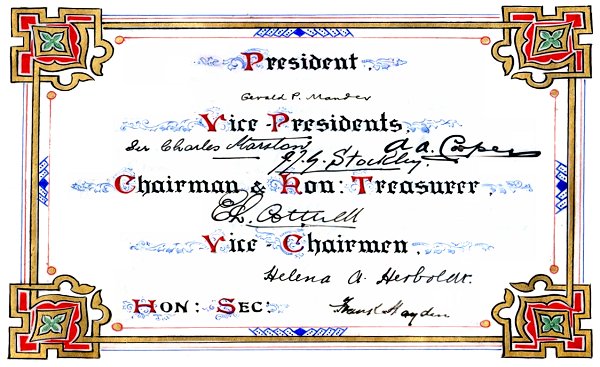
Another page from the manuscript
that was presented to James P. Jones in 1926 by the
Wolverhampton Archaeological Society. |
|
Membership remained affordable for when the Midland
Institute was charging a guinea membership, Wolverhampton
Archaeological Society’s fees remained at three shillings.
At the beginning there was controversy over what the new
society should be called. James P. Jones wrote:
|
|
When the preliminaries had been arranged, a meeting of
supporters was called by Mr. A. Wells, at St. John’s School
Cleveland St. when the formal resolution founding the new
Society was unanimously passed under the title of the
Wolverhampton Naturalist and Archaeological Society. I took
exception to the word Naturalist pointing out that some of
the members of the Free Library Section had already formed a
Naturalists Field Club – and that it was likely to cause
confusion-but I was overruled and this cumbrous title was
passed. |
|
|
James undertook various roles from vice-president, to
president,
chairman and treasurer.
He enjoyed art and won an award for his black and white
design of “Totenhalem” in the Studio Competition of 1896.
He frequently used his own photographs to illustrate his
newspaper articles, books and reports of excursions.
In 1897 he helped to form a photographers’ section and many
photographs illustrate the Society’s life over a period of
forty years.
Sadly, James’ co-founder, Alfred Webb, died in 1903.
Wolverhampton Archaeological Society had been established
for only eight years, but by this time, it was well
supported and was able to continue.
James followed articles on local history published in local
newspapers and pasted them into a series of notebooks. In
particular he followed articles by another historian,
Frederick W. Hackwood. Interestingly, Frederick Hackwood
collected articles written by James P. Jones.
In 1906
James P. Jones published the story of St. Michael and All
Angels Church, Tettenhall in The Wolverhampton Journal.
In the proof copy of his book Heart of the Midlands.
The Official Guide to Wolverhampton and its Surroundings
(also published in1906) he wrote that, as the industrial
history of the area had previously been covered by other
historians his book would concentrate on more neglected
aspects. He covered topics such as Free Libraries, Grammar
Schools, hospitals and churches of all denominations and
gave details of possible tours of the area. In 1908 he wrote
an article commemorating Oscar Gustav Rejlander,
Wolverhampton’s pioneer of early photography who died in
1875.
|
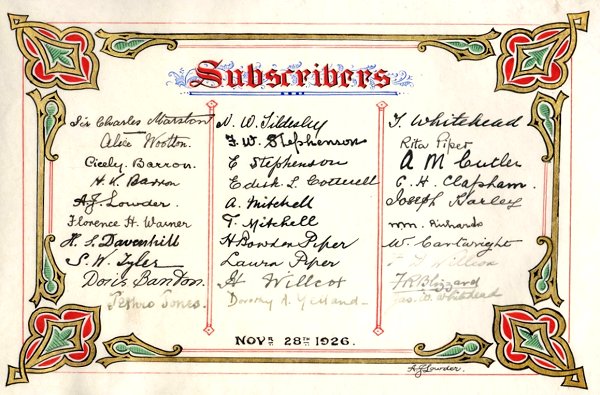
A final page from the manuscript
that was presented to James P. Jones in 1926 by the
Wolverhampton Archaeological Society. |
|
Wolverhampton Archaeological Society Excavations
Surviving evidence of Wolverhampton Archaeological Society’s
excavations is quite scarce. However,
there are clues, often found in newspapers.
A close and longstanding
connection existed between James P. Jones and Sir Charles
Hyde, the keen archaeologist, sponsor and proprietor of the
Birmingham Post. Reports from various local papers
show that
there were investigations at Wrottesley, Pennocrucium and
Wall.
James was very interested in the story of ‘The Battle of
Tettenhall’ and hoped to lead an excavation party. In
1904, when Wolverhampton Archaeological Society had been
established for approximately nine years, he wanted to
proceed with an excavation of the largest tumulus at
Wightwick, which he had written about in his article 'The
Bright Green Borderland'
that appeared in the October 1904
edition of The Wolverhampton Journal. Sadly the
excavation never happened.
An article by James P Jones, still writing for the
Birmingham Post and dated the 2nd of March
1925 records:
|
|
Viroconium Excavations
INTERESTING LECTURE AT WOLVERHAMPTON
A lecture on the excavations and discoveries at Viroconium
(Wroxeter) near Shrewsbury, was delivered to the
Wolverhampton Archaeological Society on Saturday by James P.
Jones of Tettenhall. The lecture was very comprehensive and
was illustrated by a set of slides, some were of photographs
taken thirty years ago, while others of quite recent date
were shown by the courtesy of the ‘Birmingham Post.’ In the
course of the lecture, Mr. Jones showed how the modern
safety pin was on the same principle as was used by the
Romans in the first and second centuries.
Speaking subsequently to a vote of thanks, the rector of
Wolverhampton (J.J. Stockley) mentioned that the industrial
town of Viroconium was larger than Pompeii, or of Roman
London, and he observed that Sir Charles Hyde had been a
public benefactor in making possible the more recent
excavations. One would have imagined he added, that the
State would have stepped in ere this and assisted
financially in these valuable investigations. It was
interesting to note, said the Rector that, in the matter of
heating a great modern building like Liverpool Cathedral we
were going back to the Roman system,
That sort of thing should make people love history in a real
historical sense, because of the actual accomplishments of
those distant ages. They were hopeful that the
investigations now proceeding would throw some light on the
sudden destruction of Viroconium. He pointed out that only
one third of the site had so far been excavated, and
alluding to a comment of the lecturer that a portion of the
land could not be secured because it was under cultivation,
described it as monstrous that the grazing of sheep should
take precedence over such work as the exploration of an
historical town like Viroconium. The President of the local
Society, Mr. Gerald P. Mander was in the chair and the
suggestion was made that similar lectures to a wider public
might be arranged to stimulate general interest in the
subject.
|
|
|
|
In 1926, after a bout of ill health, James P Jones stepped
down from office. In his farewell speech he gave an address
which included a retrospect of Wolverhampton Archaeological
Society’s activities and membership. He was presented
with an illuminated manuscript signed by those associated
with the Society. The names mentioned in his speech and the
signatures on the manuscript represent a piece of
Staffordshire’s history in their own right. The names and signatures
not only include historians such as W. H. Duignan, G. T.
Lawley and Sir Charles Marston but also Gerald P. Mander and
Norman W. Tildesley, people who played a vital role in
recording the history of the area. At a time when women had
just been given the vote (but only if they met certain
criteria) schoolmistress and newly registered voter, Helena
Herboldt, signed as chairperson. Several other female
members were teachers. |
|
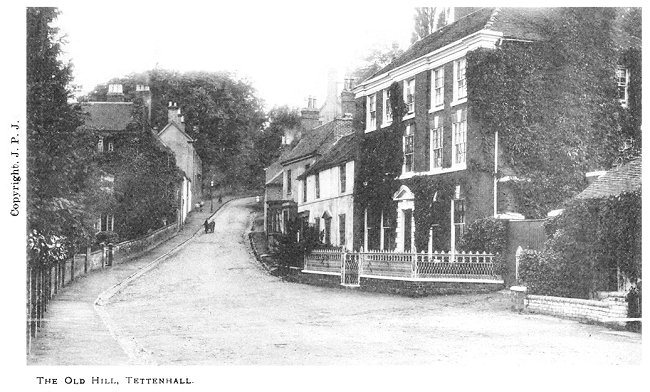
One
of James P. Jones' photos, on an old postcard. |
|
Letter of thanks from James P. Jones to Frank Hayden, Hon.
Sec, Wolverhampton Archaeological Society: |
30th November 1926.
Mr. Frank Hayden.
Hon. Secretary.
Wolverhampton Archaeological Society.
Dear Mr. Hayden,
I was deeply moved on receiving the
beautiful work of art presented to me last
Saturday, and I thank you all from the
bottom of my heart for the kind words it
contains, and for the wallet accompanying
it. :
Will you please convey to all the members my
sincere and grateful thanks for this
splendid recognition of such services as I
have been able to give to our Society; I
feel it is more than I deserve.
I shall always regard the Album as one of my
greatest treasures. It will serve to remind
me of many happy days, and pleasant
companions, upon which I can look back with
pride and thankfulness; and when I am gone
it will remain a treasured possession of my
family.
My only regret is, that my long and: serious
illness has prevented my being with you, but
it is a great joy to me to know that our
Society is so ably controlled, and that its
continued progress and prosperity are
assured.
Yours sincerely and gratefully,
James P. Jones |
|
|
|
A few months after writing this letter, James died. His
death on January 16th 1927 occurred shortly before his
seventieth birthday. He was buried in Tettenhall churchyard
on January 20th
where the service was conducted by the minister, Wilfred
Goode.
Obituaries were published in the Wolverhampton Express
and Star and in the Tamworth Herald.
An account of his funeral at St. Michael and All Angels,
Tettenhall,
taken from the Express and Star, 21st of January
1927, states.
Mr J. P. Jones
FUNERAL THIS AFTERNOON AT HISTORIC CHURCH
The body of Mr. James P. Jones who wrote a history of his
native village of Tettenhall and founded Wolverhampton
Archaeological Society, was laid to rest this afternoon in
Tettenhall Churchyard and many friends and former associates
attended to pay a last tribute to his memory.
The Revs, Wilfred Goode (Vicar), Capps and Nigel Birch
(curates) officiated at the service in the church, during
which the hymn, “Through the night of doubt and sorrow” was
sung. At the close, Mr. C.H. Duffield played Chopin’s “March
Funebre.”
Many members of his wife’s family were amongst the mourners
and coffin bearers.
The nameplate on the coffin was inscribed: “James Powell
Jones, born February 25th, 1857, died January 16th,
1927,” His grave was lined with bracken.
The intrepid and indomitable Helena Augusta Sophia Herboldt
attended the funeral together with Miss Florence
Thorneycroft, who by then had become a Staffordshire County
Councillor. Mr. A. J. Hardiman represented Tettenhall School
where, as its Honorary Secretary, James had attended prize
giving and had donated many of the awards. James’ fellow
author and historian, G. T. Lawley, was also present. The
President of Wolverhampton Archaeological Society, Gerald
Mander sent his apologies.
There were floral tributes from James’ wife Rose-Anna, his
daughter Rose, members of the Farnall family and The
Honourable Walter Bennet Wrottesley.
Sir Charles Marston was also represented as was The
Tettenhall Primrose League, Cannock Conservative
Associations, and The Commercial Travellers’ Benevolent
Institution (of which James had been a board member). The
badge of Wolverhampton Archaeological Society, the Saxon
pillar in St. Peter’s Churchyard, was worked in violets on a
background of white chrysanthemums.
His farewell was a fitting tribute to a man who had devoted
his life to recording and championing the area he loved.
Sources:
James P. Jones/ Farnall Archives, Author’s private
collection
JPJ/F Jones J.P.,
‘A Retrospect’ Handwritten notes for a farewell speech given
by J. P. Jones to Wolverhampton Archaeological Society 1926
(a copy is in Wolverhampton Archives & Local Studies).
JPJ/F Jones J.P.,
Illuminated manuscript presented to J. P. Jones upon his
retirement from Wolverhampton Archaeological Society, 1926
(a copy is in Wolverhampton Archives & Local Studies).
JPJ/F Jones J.P..,
Letter of thanks to Frank Hayden, Hon. Secretary of
Wolverhampton Archaeological Society, 30.11.1926 (copy in
Wolverhampton Archives & Local Studies).
JPJ/F Jones J.P..,
A photograph of J. P. Jones, unsigned, but otherwise
identical to the signed portrait photograph in Wolverhampton
Archives (found in D-SO-14/2-4). A note on the reverse says
that it was taken on Jones’ sixty-sixth birthday.
Wolverhampton Archives & Local Studies:
D/JPJ/ 2
Jones, J.P.,
Book containing cuttings from various local newspapers,
1897.
D/JPJ/ 3 Jones, J.P.,
Book containing cuttings from local newspapers and other
newspapers and other papers, 1902-4.
D/JPJ/ 4 Jones, J.P.,
Book containing cuttings from various local newspapers,1884.
D-SO-14/2-4 Wolverhampton Naturalist and Archaeological
Society - scrapbook.
D-GBM/20
This catalogue of chandeliers, hall lights etc. has been
used as a scrapbook for newspaper cuttings and some
handbills for events at Tettenhall Drill Hall. Much of it
appears to have been compiled by James P. Jones. It contains
the obituary of William Farnall, his father-in-law. It can
be found in the George Bradney Mitchell collection in
Wolverhampton Archives and Local Studies.
LS/1241 Antiquarian
historians of Staffordshire and their contribution to the
development of the history of Wolverhampton and its environs
between 1868 and 1951.
|
| Read some of James P. Jones' articles
from the Wolverhampton Journal: |
 |
|
Tettenhall - The Bright Green Borderland. October
1904. |
 |
|
Tettenhall Church, Past and Present. September to
November 1906. |
 |
|
O. G. Rejlander. March 1908. |
 |
|
The Bicentenary of Dr. Johnson. October 1909. |
 |
Return to
Lives
of Local People |
|